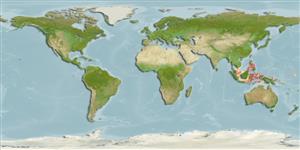Classification / Names
Common names from other countries
Main reference
Size / Weight / Age
Max length : 2.8 cm SL male/unsexed; (Ref. 75753)
Environment
Marine; demersal; depth range 0 - 73 m (Ref. 75753)
Climate / Range
Tropical, preferred ?
Distribution
Short description
Dorsal
spines
(total): 3;
Dorsal
soft rays
(total): 20-23;
Anal
soft rays: 20 - 25;
Vertebrae: 35 - 36. This species differs from other species of the Pteropsaron/Osopsaron complex in having only 3 dorsal spines which are displaced anteriorly to lie over the posterior end of the skull, and associated modification of the anteriormost 3 pterygiophores and neural spines; D III, 20-23; A 24-25; vertebrae 35-36 (Ref. 75753).
IUCN Red List Status (Ref. 115185)
Human uses
More information
Common namesSynonymsMetabolismPredatorsEcotoxicologyReproductionMaturitySpawningFecundityEggsEgg development
Age/SizeGrowthLength-weightLength-lengthLength-frequenciesMorphometricsMorphologyLarvaeLarval dynamicsRecruitmentAbundance
ReferencesAquacultureAquaculture profileStrainsGeneticsAllele frequenciesHeritabilityDiseasesProcessingMass conversion
Tools
Special reports
Download XML
Internet sources
Estimates of some properties based on models
Phylogenetic diversity index
PD50 = 0.5020 many relatives (e.g. carps) 0.5 - 2.0 few relatives (e.g. lungfishes)
Trophic Level
3.2 ±0.3 se; Based on size and trophs of closest relatives
Resilience
High, minimum population doubling time less than 15 months (Preliminary K or Fecundity.)
Vulnerability
Low vulnerability (10 of 100)
Price category
